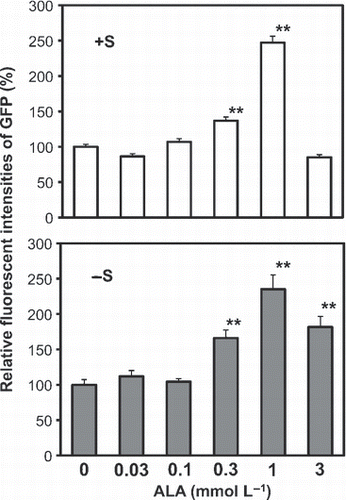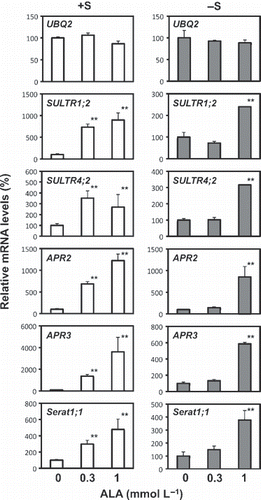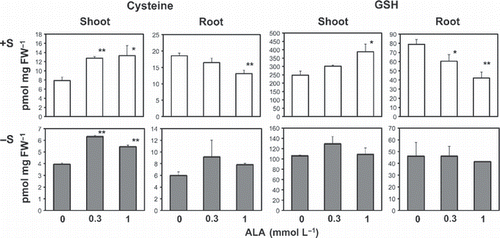Figures & data
Figure 1 Induction of green fluorescent protein (GFP) accumulation in PSULTR1;2-GFP plants by 5-aminolevulinic acid (ALA) treatment. The PSULTR1;2-GFP plants were grown for 7 days on control agar medium and then incubated for 2 days on the control medium or on medium containing 0.03, 0.1, 0.3, 1 or 3 μmol L−1 of ALA. The medium used for the experiment contained 1500 (+S) or 15 μ mol L−1 (−S) sulfate as a sulfur source. The relative fluorescent intensities in the roots were quantified by ImageQuant software. The relative values indicate comparisons with the control plants (0 mmol L−1 ALA). Error bars indicate the standard error. Statistically significant differences from the control with P-values <0.05 are shown as ** (n = 11).

Figure 2 Induction of mRNA accumulation of sulfur assimilatory genes by 5-aminolevulinic acid (ALA) treatment. Plants were treated as described in Fig. 1 except that the plants used were wild-type Columbia and the ALA concentrations were 0, 0.3 and 1 mmol L−1. The mRNA contents of SULTR1;2, SULTR4;2, APR2, APR3, Serat2;1 and UBQ2 in the root tissues were determined by real-time reverse transcription-polymerase chain reaction. The relative values indicate comparisons with the control plants (0 mmol L−1 ALA). Statistically significant differences from the control with P-values <0.05 are shown as ** (n = 3).

Figure 3 Effects of 5-aminolevulinic acid (ALA) treatment on the sulfate uptake activities in plants. Plants were treated as described in Fig. 2. The medium used for the experiment contained 1500 (+S) or 15 μ mol L−1 (−S) sulfate as a sulfur source. Statistically significant differences from the control with P-values <0.05 are shown as ** (n = 8). FW, fresh weight.

Figure 4 Effects of 5-aminolevulinic acid (ALA) treatment on cysteine and glutathione (GSH) accumulation in plants. Plants were treated as described in Fig. 2. The medium used for the experiment contained 1500 (+S) or 15 μ mol L−1 (−S) sulfate as a sulfur source. Statistically significant differences from the control are shown. *P < 0.1; **P < 0.05 (n = 4). FW, fresh weight.
